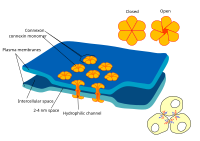Electrical synapse

An electrical synapse is like a little door between two cells that lets them talk to each other really quickly. Imagine you and your friend each have a phone, and you want to tell them something really quickly. You could call them on the phone and wait for them to answer. But if you were right next to them, you could just whisper in their ear and they'd hear you instantly, with no lag time. That's kind of like how an electrical synapse works.
In your body, there are lots of cells called neurons that help you think, feel, and move. These neurons need to send messages to each other really quickly in order for your body to work properly. When one neuron wants to talk to another, it sends a little electrical signal down its axon, which is like a long tail. This electrical signal arrives at the end of the axon, where it meets the next neuron at a little gap called a synapse.
Now, there are two types of synapses: chemical and electrical. Chemical synapses are like sending a letter through the mail. The electrical signal in one neuron triggers the release of chemicals called neurotransmitters, which float across the gap and activate receptors on the other neuron. This process takes a little bit of time and uses up energy.
But electrical synapses are like tapping your friend on the shoulder. At an electrical synapse, the electrical signal can actually jump directly from one cell to the other through little channels called gap junctions. This happens really quickly, and doesn't use up as much energy as chemical synapses.
So why don't all neurons use electrical synapses? Well, they have their pros and cons. Electrical synapses are great for transmitting really fast, reliable signals. But they aren't as flexible as chemical synapses. At a chemical synapse, the neurotransmitters can activate different receptors on the receiving neuron depending on the situation. This allows for more complex signaling and processing of information.
Overall, electrical synapses are like a secret shortcut between neurons that lets them talk really quickly. They're not as versatile as chemical synapses, but they're very useful for certain types of communication in your brain and nervous system.
In your body, there are lots of cells called neurons that help you think, feel, and move. These neurons need to send messages to each other really quickly in order for your body to work properly. When one neuron wants to talk to another, it sends a little electrical signal down its axon, which is like a long tail. This electrical signal arrives at the end of the axon, where it meets the next neuron at a little gap called a synapse.
Now, there are two types of synapses: chemical and electrical. Chemical synapses are like sending a letter through the mail. The electrical signal in one neuron triggers the release of chemicals called neurotransmitters, which float across the gap and activate receptors on the other neuron. This process takes a little bit of time and uses up energy.
But electrical synapses are like tapping your friend on the shoulder. At an electrical synapse, the electrical signal can actually jump directly from one cell to the other through little channels called gap junctions. This happens really quickly, and doesn't use up as much energy as chemical synapses.
So why don't all neurons use electrical synapses? Well, they have their pros and cons. Electrical synapses are great for transmitting really fast, reliable signals. But they aren't as flexible as chemical synapses. At a chemical synapse, the neurotransmitters can activate different receptors on the receiving neuron depending on the situation. This allows for more complex signaling and processing of information.
Overall, electrical synapses are like a secret shortcut between neurons that lets them talk really quickly. They're not as versatile as chemical synapses, but they're very useful for certain types of communication in your brain and nervous system.
Related topics others have asked about:
